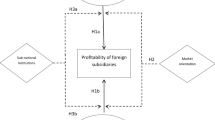Abstract
This paper examines whether local protection has hindered China's market integration process using a firm-level data set. Our empirical results show that an industry's geographic concentration level is negatively correlated with its labour productivity while its concentration at plant level is not. Since labour productivity is strongly positively correlated with an industry's profitability, this evidence supports Bai et al.'s (2004) argument that local government has a stronger incentive to protect highly profitable industries. We also find that a province's market shares of its protected industries grow faster than other industries, which also supports the argument that local protection slows down China's market integration process.


Similar content being viewed by others
Notes
This idea is first proposed by Bai et al. (2004).
Because Σ p Δs pit ≡0, Σ p (y pit −y pt )≡0, Σ p Δs pt ≡0, we have α0≡0.
Ellison and Glaeser (1997) consider industries with γ<0.02 as ‘not very localised’ and these with γ>0.05 as ‘very localised’.
The Hausman test cannot reject the hypothesis that the estimates of the random-effect model are consistent at any conventional statistical level.
References
Bai, C-E, Du, Y, Tao, Z and Tong, SY . 2004: Local protectionism and regional specialization: Evidence from China's industries. Journal of International Economics 63 (2): 397–417.
Bain, JS . 1951: Relation of profit rate to industry concentration: American manufacturing, 1936–1940. Quarterly Journal of Economics 65 (3): 293–324.
Dalton, JA and Penn, DW . 1976: The concentration–profitability relationship: Is there a critical concentration ratio? Journal of Industrial Economics 25 (2): 133–142.
Dumais, G, Ellison, G and Glaeser, EL . 2002: Geographic concentration as a dynamic process. Review of Economics and Statistics 84 (2): 193–204.
Ellison, G and Glaeser, EL . 1997: Geographic concentration in US manufacturing industries: A dartboard approach. Journal of Political Economy 105 (5): 889–927.
Kumar, A . 1994: China: internal market development and regulation. World Bank Publications: Washington, DC.
Naughton, B . 2003: How much can regional integration do to unify China's markets? In: Hope, NC, Yang, DT, Yang, ML and Li, MY (eds). How Far Across the River? Chinese Policy Reform at the Millennium, Chapter 8, pp. 204–232. Stanford University Press: Stanford, CA.
Park, A, Jin, H, Rozelle, S and Huang, J . 2002: Market emergence and transition: Arbitrage, transaction costs, and autarky in China's grain markets. American Journal of Agricultural 84 (1): 67–82.
Poncet, S . 2003: Measuring Chinese domestic and international integration. China Economic Review 14 (1): 1–21.
Poncet, S . 2005: A fragmented China: Measure and determinants of Chinese domestic market disintegration. Review of International Economics 13 (3): 409–430.
Young, A . 2000: The razor's edge: Distortions and incremental reform in the People's Republic of China. Quarterly Journal of Economics 115 (4): 1091–1135.
Zhang, X and Tan, K . 2007: Incremental reform and distortions in China's product and factor markets. World Bank Economic Review 21 (2): 279–299.
Author information
Authors and Affiliations
Appendix: Variable definitions
Appendix: Variable definitions
-
1)
Labour productivity of industry i is defined as,

where y j is the value added of firm j in industry i, and e j is the number of employees of firm j.
-
2)
Labour productivity of industry i in province p is defined as,

where y j is the value added of firm j in industry i of province p and e j is the number of employees of firm j.
-
3)
The standard deviation of labour productivity of industry i is defined as

where P is the number of provinces.
-
4)
The market share of province p is defined as,

where q is the sales of firm j.
-
5)
The market share of province p in industry i is defined as,

where q is the sales of firm j.
Rights and permissions
About this article
Cite this article
Liu, H., Tong, S. Market Segmentation and the Location of Production Activities. Comp Econ Stud 51, 302–322 (2009). https://doi.org/10.1057/ces.2008.49
Published:
Issue Date:
DOI: https://doi.org/10.1057/ces.2008.49









